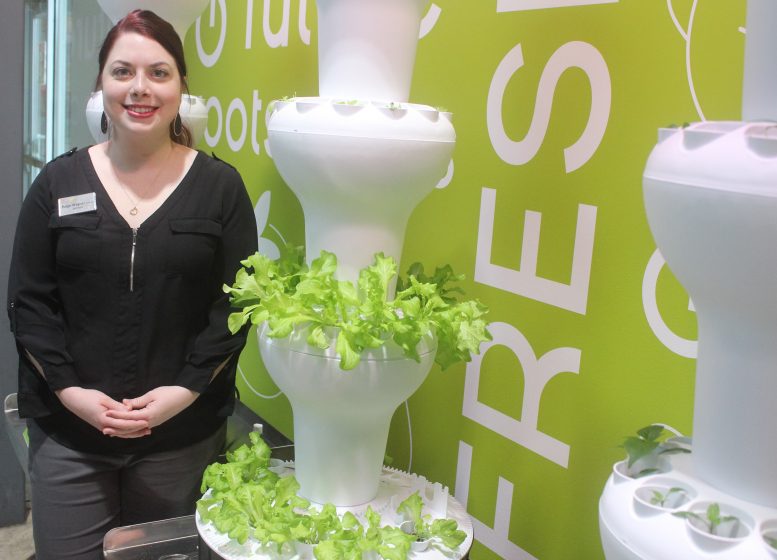By DAVID DUPONT
BG Independent News
When students returned to campus in the chill of winter — so cold classes were canceled for two days — they still could get a taste fresh greens harvested on campus.
Over Winter Session, a five-tower hydroponic growing system was installed in Bowling Green State University’s Oaks Dining Center.
Lettuce grown in the dead of winter was livening up the menu in the vegan-friendly Shoots station in the Oaks.
Mike Paulus, director of dining services, planted the seed for the project last October. It serves a double function, he said. The sustainable system teaches students about being socially responsible, and it helps keep the cost down for dining services — the cost of the system is expected to be recouped by savings on food costs.
Paige Wagner, campus dietician and teaching kitchen coordinator, said once the idea was suggested, she and Dave Beaverson, facilities director, researched systems and came back with a plan of action.
The five towers were installed over Winter Session. Within a couple weeks, Wagner was harvesting lettuce, about 30 cups worth.
She said she expects to get 30 harvests over the course of the semester. That’s a conservative estimate.
Lettuce is the first to come in, but there are herbs in the works as well as peppers and cherry tomatoes.
Produce grows twice as fast as usual in the system.
She said they are also looking at investing in a vining system to grow full size tomatoes, an in-demand ingredient.
“That’s something we’ll invest in once we see how all this goes,” she said.…
Lettuce was the first, Wagner said, because “it’s the easiest one to grow and the hardest one to kill.”
The system has no soil. A sponge keeps the plants’ roots moist, and that means the system consumes only a tenth of the water traditional farming does.
With a 10-gallon tank for each tower, that means no regular watering, just a top-off now and then.
Wagner said she does have to regularly check the pH level of the system to make sure it stays in the slightly acidic range, 5.5-6, that the plants prefer.
Wagner documents the plants’ growth and how much they’re yielding as well as how much fertilizer is added.
The hardest part, she said, was the trial and error involved in getting the new system up and running, figuring out what grows well and how to place the plants under the lights.
The system uses no herbicides or pesticides, and about 60 percent less fertilizer.
Wagner said she hopes to have the system certified as organic, but that’s a long, involved process.
The new approach “is one way to help students to eat healthy,” she said, as well as to be more sustainable.
“This is a way to use less water, less fertilizer, less soil. We can grow it in our building rather than having to take green space outside.”
Eventually Wagner would like to have students have a greater role in the project. Studies show that being involved in growing food is good for mental health, she said.
But, Wagner added, “we also have to be really careful about people touching them, which is why it’s roped off. We don’t want people contaminating our plants.”

